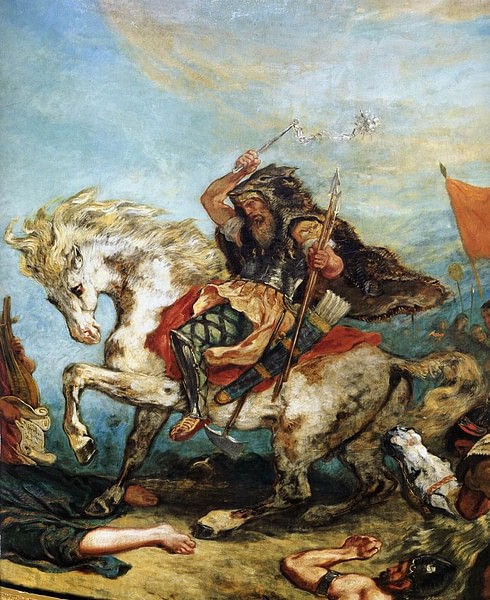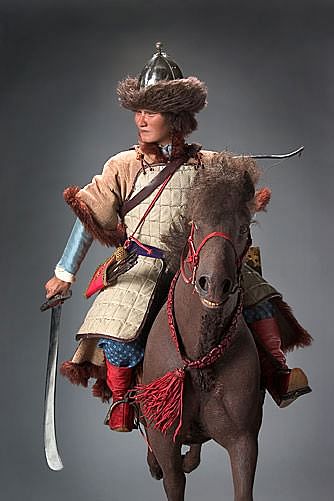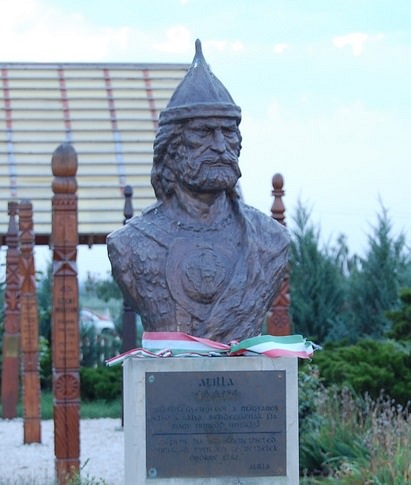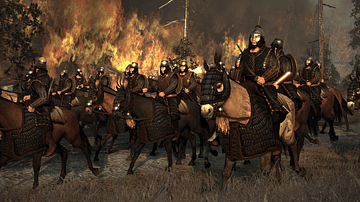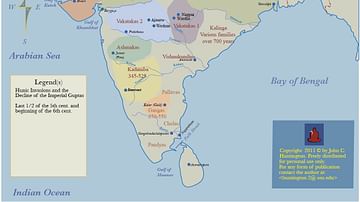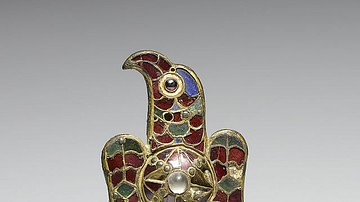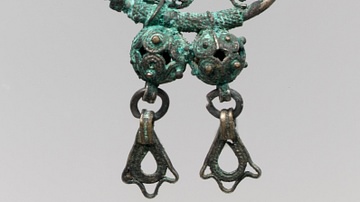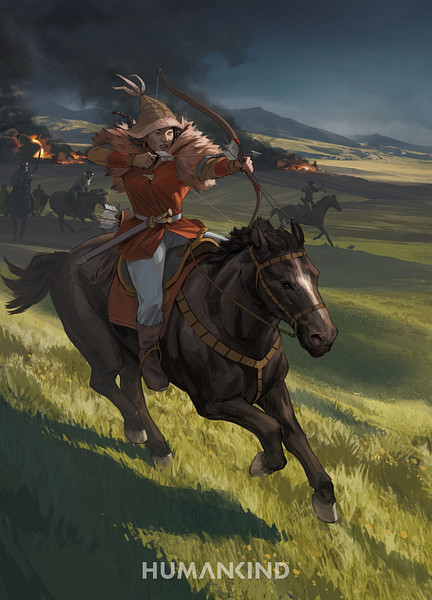
The Huns were a nomadic tribe prominent in the 4th and 5th century whose origin is unknown but, most likely, they came from "somewhere between the eastern edge of the Altai Mountains and the Caspian Sea, roughly modern Kazakhstan" (Kelly, 45). They became a formidable fighting force, displacing many other peoples, and contributed to the fall of Rome.
They are first mentioned in Roman sources by the historian Tacitus (Fragments, 7) in c. 91 as people who had been feared in the past but were defeated ("I mean the Alans, the Huns, and the Goths") and, at this time, are not mentioned as any more of a threat to Rome than any other barbarian tribes.
In time, this would change as the Huns became one of the primary contributors to the fall of the Roman Empire, as their invasions of the regions around the empire, which were particularly brutal, encouraged what is known as the Great Migration (also known as the "Wandering of the Nations") between roughly 376-476. This migration of peoples, such as the Alans, Goths, and Vandals, disrupted the status quo of Roman society, and their various raids and insurrections weakened the empire.
To cite only one example, the Visigoths under Fritigern were driven into Roman territory by the Huns in 376 and, after suffering abuses by Roman administrators, rose in revolt, initiating the First Gothic War with Rome of 376-382, in which the Romans were defeated, and their emperor Valens killed, at the Battle of Adrianople in 378.
Although the Huns are routinely depicted as savage and bestial, especially by ancient writers such as Jordanes (6th century) and Ammianus Marcellinus (4th century), Priscus of Panium (5th century) depicts them in a better light. Priscus actually met Attila the Hun, dined with him, and stayed in the Hun settlement; his description of Attila and the Hun lifestyle is one of the better known and certainly one of the most flattering.
Under Attila (r. 434-453) the Huns became the most powerful, and most feared, military force in Europe and brought death and devastation wherever they went. After Attila's death, however, his sons fought each other for supremacy, squandered their resources, and the empire which Attila had built fell apart by 469.
Origins & Link with Xiongnu
In attempting to locate the origin of the Huns, scholars since the 18th century have speculated that they may have been the mysterious Xiongnu people who harassed the borders of northern China, especially during the Han Dynasty (202 BCE-220 CE). Like the Huns, the Xiongnu were nomadic, mounted warriors who were especially adept with the bow and struck without warning. The French orientalist and scholar Joseph de Guignes (1721-1800) first proposed that the Huns were the same people as the Xiongnu, and others have since worked to find support for his claim or argued against it.
In modern scholarship there is no consensus on the Xiongnu-Hun link but, largely, it has been rejected for lack of evidence. The historian Christopher Kelly interprets the attempt to link the Xiongnu with the Huns as stemming from a desire to not only locate a definitive locale for Hunnic origins but also to define the struggle between the Huns and Rome as a battle between the "noble west" and the "barbaric east". Kelly suggests:
For some writers, connecting the Xiongnu and the Huns was part of a wider project of understanding the history of Europe as a fight to preserve civilization against an ever-present oriental threat. The Huns were a warning from history. With their Chinese credentials established, their attacks on the Roman empire could be presented as part of an inevitable cycle of conflict between East and West. (43)
Kelly, citing other scholars for support, concludes that there is no reason to link the Xiongnu with the Huns and notes that Guignes was working at a time when archaeological evidence on both the Xiongnu and the Huns was scarce. He writes:
Understanding of the Xiongnu changed significantly in the 1930's with the publication of bronze artifacts from the Ordos Desert, in Inner Mongolia, west of the Great Wall. These demonstrated the striking difference between the art of the Xiongnu and that of the Huns. Not one object found in eastern Europe dating from the fourth and fifth centuries AD is decorated with the beautiful stylized animals and mythical creatures that are characteristic of Xiongnu design. (44)
He cites the scholar Otto Maenchen-Helfen who observed:
The Ordos bronzes were made by or for the [Xiongnu]. We could check all items in the inventory of the Ordos bronzes, and we would not be able to point out a single object which could be paralleled by one found in the territory once occupied by the Huns...There are the well-known motifs of the animal style...not a single one from that rich repertoire of motifs has ever been found on a Hunnish object. (44)
Kelly, with the support of others, concludes that Kazakhstan is the most likely point of origin for the Huns but notes that "it is regrettably impossible to suggest anything more precise" (45). For the ancient writers, however, discerning the origin of the Huns was simple: they were evil beasts who had emerged from the wilderness to wreak havoc on civilization. Ammianus does not speculate on their origin but describes them in his History of Rome:
The nation of the Huns surpasses all other barbarians in wildness of life. And though [the Huns] do just bear the likeness of men (of a very ugly pattern), they are so little advanced in civilization that they make no use of fire, nor any kind of relish, in the preparation of their food, but feed upon the roots which they find in the fields, and the half-raw flesh of any sort of animal. I say half-raw, because they give it a kind of cooking by placing it between their own thighs and the backs of their horses. When attacked, they will sometimes engage in regular battle. Then, going into the fight in order of columns, they fill the air with varied and discordant cries. More often, however, they fight in no regular order of battle, but by being extremely swift and sudden in their movements, they disperse, and then rapidly come together again in loose array, spread havoc over vast plains, and flying over the rampart, they pillage the camp of their enemy almost before he has become aware of their approach. It must be owned that they are the most terrible of warriors because they fight at a distance with missile weapons having sharpened bones admirably fastened to the shaft. When in close combat with swords, they fight without regard to their own safety, and while their enemy is intent upon parrying the thrust of the swords, they throw a net over him and so entangle his limbs that he loses all power of walking or riding. (XXXI.ii.1-9)
Jordanes, on the other hand, devotes considerable space to the origin of the Huns:
We learn from old traditions that their origin was as follows: Filimer, king of the Goths, son of Gadaric the Great, who was the fifth in succession to hold the rule of the Getae, after their departure from the island of Scandza...found among his people certain witches. Suspecting these women, he expelled them from the midst of his race and compelled them to wander in solitary exile afar from his army. There the unclean spirits, who beheld them as they wandered through the wilderness, bestowed their embraces upon them and begat this savage race, which dwelt at first in the swamps, a stunted, foul and puny tribe, scarcely human and having no language save one which bore but slight resemblance to human speech. (85)
The Huns, once they were given birth to by these witches mating with demons, then "settled on the farther bank of the Maeotic swamp." Jordanes goes on to note how "they were fond of hunting and had no skill in any other art. After they had grown to a nation, they disturbed the peace of neighboring races by theft and rapine" (86). They entered into civilization when one of their hunters was pursuing game on the farthest edge of the Maeotic swamp and saw a doe who led them across the swamp, "now advancing and again standing still", which showed them that the swamp could be crossed whereas, before, "they had supposed [the swamp] was impassable as the sea" (86). Once they reached the other side, they discovered the land of Scythia and, at that moment, the doe vanished. Jordanes continues:
Now in my opinion, the evil spirits, from whom the Huns are descended, did this from envy of the Scythians. And the Huns, who had been wholly ignorant that there was another world beyond Maeotis, were now filled with admiration for the Scythian land. As they were quick of mind, they believed that this path, utterly unknown to any age of the past, had been divinely revealed to them. They returned to their tribe, told them what had happened, praised Scythia and persuaded the people to hasten thither along the way they had found by the guidance of the doe. As many as they captured, when they thus entered Scythia for the first time, they sacrificed to Victory. The remainder they conquered and made subject to themselves. Like a whirlwind of nations they swept across the great swamp. (86)
While Jordanes' depiction of the Huns is obviously biased, his observation of them moving "like a whirlwind" is consistent with other's descriptions. The Huns are routinely characterized by mobility and ferocity; they struck without warning and observed no distinction between combatants and non-combatants, men, women, or children. Once they had crossed the swamp, and conquered Scythia, there seemed no stopping them.
The Huns & Rome
The speed with which the Huns moved, and their success in battle, is best illustrated in their conquest of the region which comprises Hungary in the present day. In 370 they conquered the Alans and, by 376, had driven the Visigoths under Fritigern into Roman territory and those under the leadership of Athanaric to the Caucalands by c. 379.
The Huns continued their invasion of the region and, as historian Herwig Wolfram writes, citing the ancient source of Ambrose, the chaos this caused was widespread: "the Huns fell upon the Alans, the Alans upon the Goths, and the Goths upon the [tribes of] the Taifali and Sarmatians" (73). Many of these tribes, besides the Goths, sought refuge in Roman territory and, when it was denied, they took it upon themselves to find a way in to escape from the Huns.
Between 395-398, the Huns overran the Roman territories of Thrace and Syria, destroying cities and farmlands in their raids but showing no interest in settling in the regions. At this same time, there were Huns who were serving in the Roman army, as Foederati and Hun settlements had been approved by Rome in Pannonia. The seeming discrepancy in the Huns being both allies and enemies of Rome is resolved when one understands that, at this time, the Huns were under no central leader. Within the tribe as a whole, it seems, were sub-tribes or factions, which each followed its own chief. For this reason, it is often difficult to determine what the overall Hun objectives were at this time other than, as Jordanes notes, "theft and rapine".
Their pressure on surrounding tribes, and on Rome, continued as they raided at will and without restraint. Wolfram, citing the Goths under Athanaric as an example, writes:
The Thervingi had no hope of surviving in a ravaged land that a new type of enemy could destroy at will, practically without advance warning. No one knew how to defend against the Huns. (72)
This same paradigm held for all the tribes of people who once lived in the regions beyond the Roman borders. In December of 406, the Vandals crossed the frozen Rhine River and invaded Gaul to escape the Huns and brought the remnants of many other tribes along with them. The Romans had no better luck in fending off Hunnic attacks than any other people. In 408, the chief of one group of Huns, Uldin, completely ransacked Thrace and, as Rome could do nothing to stop them militarily, they tried to pay them for peace. Uldin, however, demanded too high a price, and so the Romans opted to buy off his subordinates. This method of keeping the peace was successful and would become the preferred practice for the Romans in dealing with the Huns from then on.
It is hardly surprising that the Romans chose to pay off the Huns for peace rather than face them on the field. To emphasize Ammianus' description of the Hun's tactics in war, already cited above:
They fight in no regular order of battle, but by being extremely swift and sudden in their movements, they disperse, and then rapidly come together again in loose array, spread havoc over vast plains, and flying over the rampart, they pillage the camp of their enemy almost before he has become aware of their approach.
They were expert horsemen, described as seeming to be one with their steeds; they were rarely seen dismounted and even carried on negotiations from the backs of their horses. Neither the Romans nor the so-called barbarian tribes had ever encountered an army like the Huns.
They seemed to have been bred for mounted warfare and used the bow with great effect. The historian and former US Army Lt. Col. Michael Lee Lanning describes the Hun army thusly:
Hun soldiers dressed in layers of heavy leather greased with liberal applications of animal fat, making their battle dress both supple and rain resistant. Leather-covered, steel-lined helmets and chain mail around their necks and shoulders further protected the Hun cavalrymen from arrows and sword strikes. The Hun warriors wore soft leather boots that were excellent for riding but fairly useless for foot travel. This suited the soldiers, for they were much more comfortable in the saddle than on the ground. (62)
Their ability to appear out of nowhere, attack like a whirlwind, and vanish away made them incredibly dangerous opponents who seemed impossible to defeat or defend against. The Hun fighting force, already formidable, would become more so with their unification under the most famous of the Huns: Attila.
The Co-Reign of Attila & Bleda
By 430, a Hun chief named Rugila was known to the Romans as King of the Huns. Whether he actually ruled over all the Huns or simply the largest faction is not known. Some scholars, such as Mladjov, claim a Hunnic king named Balamber initiated a dynasty and was Rugila's grandfather while others, such as Sinor, claim that Balamber was only the leader of one sub-set, or faction, of the Huns or may never have existed at all. If Mladjov's claims are accepted, then Rugila was king of all the Huns but this seems unlikely as there is no evidence of unity at the time he was leading his raids.
Rugila had two nephews, Attila and Bleda (also known as Buda) and, when he died on campaign in 433, the two brothers succeeded him and ruled jointly. Attila and Bleda together brokered the Treaty of Margus with Rome in 439. This treaty continued the precedent of Rome paying off the Huns in return for peace, which would be a more or less constant stipulation in Roman-Hun relations until Attila's death. Once the treaty was concluded, the Romans were able to withdraw their troops from the Danube region and send them against the Vandals who were threatening Rome's provinces in Sicily and North Africa. The Huns turned their attention east after the Margus Treaty and warred against the Sassanid Empire but were repelled and driven back toward the Great Hungarian Plain, which was their home base.
With the Roman troops who once guarded the border now deployed to Sicily, the Huns saw an opportunity for easy plunder. Kelly writes, "As soon as Attila and Bleda received reliable intelligence that the fleet had left for Sicily, they opened their Danube offensive" (122). In the summer of 441, Attila and Bleda drove their armies through the border regions and sacked the cities of the province of Illyricum, which were very profitable Roman trade centers. They then further violated the Treaty of Margus by riding on to that city and destroying it. The Roman emperor Theodosius II (401-450) then declared the treaty broken and recalled his armies from the provinces to stop the Hun rampage.
Attila and Bleda responded with a full-scale invasion, sacking and destroying Roman cities all the way to within 20 miles of the Roman capital of Constantinople. The city of Naissus, birthplace of the emperor Constantine the Great, was razed and would not be rebuilt for a century afterwards. The Huns had learned a great deal about siege warfare from their time serving in the Roman army and expertly put this knowledge to use, literally wiping whole cities, such as Naissus, off the map. Their offensive was all the more successful because it was completely unexpected. Theodosius II had been so confident that the Huns would keep the treaty that he refused to listen to any council that suggested otherwise. Lanning comments on this, writing:
Attila and his brother valued agreements little and peace even less. Immediately upon assuming the throne, they resumed the Hun offensive against Rome and anyone else who stood in their way. Over the next ten years, the Huns invaded territory which today encompasses Hungary, Greece, Spain, and Italy. Attila sent captured riches back to his homeland and drafted soldiers into his own army while often burning the overrun towns and killing their civilian occupants. Warfare proved lucrative for the Huns but wealth apparently was not their only objective. Attila and his army seemed genuinely to enjoy warfare, the rigors and rewards of military life were more appealing to them than farming or attending livestock. (61)
Theodosius II, realizing he was defeated but unwilling to admit total defeat, asked for terms; the sum Rome now had to pay to keep the Huns from further destruction was more than tripled. In 445 Bleda vanishes from the historical record and Kelly cites Priscus of Panium on this: "Bleda, king of the Huns, was assassinated as a result of the plots of his brother Attila" (129). Other sources seem to indicate that Bleda was killed on campaign but, as Priscus is considered the most reliable source, it is generally accepted that Attila had him murdered. Attila now became the sole ruler of the Huns and commander of the most powerful fighting force in Europe.
Historian Will Durant (following the descriptions from ancient accounts like those of Priscus) writes of Attila:
He differed from the other barbarian conquerors in trusting to cunning more than to force. He ruled by using the heathen superstitions of his people to sanctify his majesty; his victories were prepared by the exaggerated stories of his cruelty which perhaps he had himself originated; at last even his Christian enemies called him the "scourge of God" and were so terrified by his cunning that only the Goths could save them. He could neither read nor write, but this did not detract from his intelligence. He was not a savage; he had a sense of honor and justice, and often proved himself more magnanimous than the Romans. He lived and dressed simply, ate and drank moderately, and left luxury to his inferiors, who loved to display their gold and silver utensils, harness, and swords, and the delicate embroidery that attested the skillful fingers of their wives. Attila had many wives, but scorned that mixture of monogamy and debauchery which was popular in some circles of Ravenna and Rome. His palace was a huge loghouse floored and walled with planed planks, but adorned with elegantly carved or polished wood, and reinforced with carpets and skins to keep out the cold. (39)
Priscus' depiction of Attila, whom he met while on a diplomatic mission for the Eastern Empire in 448/449, portrays him as a careful and sober leader who was greatly respected by his people and, in contrast to the luxury of Roman rulers, lived simply. Priscus describes his dinner with Attila as a courteous affair in which Attila was never seen to over-indulge:
When all were arranged in order a cupbearer approached and offered Attila an ivy-wood cup of wine. He took it and saluted the first in rank, and the one honored by the greeting stood up. It was not right for him to sit down until the king had either tasted the wine or drunk it up and had given the cup back to the cupbearer. All those present honored him in the same way as he remained seated, taking the cups and, after a salutation, tasting them. Each guest had his own cupbearer who had to come forward in order when Attila's cupbearer retired. After the second man had been honored and the others in order, Attila greeted us also with the same ritual according to the order of the seats. When everyone had been honored by this salutation the cupbearers went out, and tables for three or four or more men were set up next to that of Attila. From these each was able to partake of the things placed on his plate without leaving the original arrangement of chairs. Attila's servant was the first to enter, bearing a platter full of meat, and then the servants who waited on the rest placed bread and viands on the tables. While sumptuous food had been prepared—served on silver plates—for the other barbarians and for us; for Attila there was nothing but meat on a wooden trencher. He showed himself temperate in all other ways too, for gold and silver goblets were offered to the men at the feast, but his mug was of wood. His dress too was plain, having care for nothing other than to be clean, nor was the sword by his side, nor the clasps of his barbarian boots, nor the bridle of his horse, like those of other Scythians, adorned with gold or gems or anything of high price. (Fragment 8)
Kelly observes that Priscus' Roman readers would have been expecting a vastly different portrait of the "scourge of God" and would have contrasted Priscus' description against what they knew of Roman excess. Kelly writes, "For nearly five hundred centuries, ever since the first Roman emperor Augustus, behavior at banquets had been one of the moral measures of a ruler" and notes how "the absence of drunkenness, gluttony, and excess would have been most striking [in Priscus' account]. Attila's behavior displayed a degree of moderation and restraint that could favorably be compared with that of the best of emperors" (198). Even though Attila could be restrained and courteous in a domestic setting, on the battlefield he was unstoppable.
Between 445-451, Attila the Hun led his armies on numerous raids and successful campaigns, slaughtering the inhabitants of the regions and leaving a swath of destruction in his wake. In 451, he was met by the Roman general Flavius Aetius (l. 391-454) and his ally Theodoric I of the Visigoths (r. 418-451) at the Battle of the Cataluanian Plains (also known as The Battle of Chalons) where he was defeated for the first time. In 452 he invaded Italy and was responsible for the creation of the city of Venice in that the inhabitants of the cities and towns fled to the marshes for safety and eventually built homes there. His Italian campaign was no more successful than his invasion of Gaul, and he returned again to his base on the Great Hungarian Plain.
Attila's Death and Dissolution of the Hun Empire
By 452, Attila's empire stretched from the regions of present-day Russia down through Hungary and across Germany to France. He received regular tribute from Rome and, in fact, was paid a salary as a Roman general even as he was raiding Roman territories and destroying Roman cities. In 453 Attila married a young woman named Ildico and celebrated his wedding night, according to Priscus, with too much wine. Jordanes, following Priscus' report, describes Attila's death:
He had given himself up to excessive joy at his wedding, and as he lay on his back, heavy with wine and sleep, a rush of superfluous blood, which would ordinarily have flowed from his nose, streamed in deadly course down his throat and killed him, since it was hindered in the usual passages. Thus did drunkenness put a disgraceful end to a king renowned in war. (123)
The entire army fell into intense grief over the loss of their leader. Attila's horsemen smeared their faces with blood and rode slowly, in a steady circle, around the tent which held his body. Kelly describes the aftermath of Attila's death:
According to the Roman historian Priscus of Panium, they [the men of the army] had cut their long hair and slashed their cheeks "so that the greatest of all warriors should be mourned not with tears or the wailing of women but with the blood of men." Then followed a day of grief, feasting, and funeral games; a combination of celebration and lamentation that had a long history in the ancient world. That night, far beyond the frontiers of the Roman empire, Attila was buried. His body was encased in three coffins; the innermost covered in gold, a second in silver, and a third in iron. The gold and silver symbolized the plunder that Attila had seized while the harsh gray iron recalled his victories in war. (6)
According to legend, a river was then diverted, Attila buried in the river's bed, and the waters then released to flow over it covering the spot. Those who had taken part in the funeral were killed so that the burial place might never be revealed. According to Kelly, "these, too, were honorable deaths", in that they were part of the funeral honors for the great warrior who had brought his followers so far and accomplished so much for them.
Once his funeral services were concluded, his empire was divided among his three sons Ellac, Dengizich, and Ernakh. Attila's commanding presence and fearsome reputation had kept the empire together and, without him, it began to break apart. The three brothers fought each other for their own best interests instead of placing the interests of the empire first. Each brother claimed a region, and the people in it, as their own and, as Jordanes writes, "When Ardaric, king of the Gepidae, learned this, he became enraged because so many nations were being treated like slaves of the basest condition, and was the first to rise against the sons of Attila" (125). Ardaric defeated the Huns at the Battle of Nedao in 454 in which Ellac was killed.
After this engagement, other nations broke away from Hunnic control. Jordanes notes that, by Ardaric's revolt, "he freed not only his own tribe, but all the others who were equally oppressed" (125). The empire of the Huns dissolved, and the people were absorbed into the cultures of those they had formerly reigned over. Reprisals for earlier wrongs seem to have been carried out, as evidenced by the Goth massacre of the Huns of Pannonia after the empire had fallen.
After the year 469 there is no longer any mention of Hunnic campaigns, settlements, nor any activity concerning them at all as the formidable army they had been. Aside from ancient historian's comparisons between the Huns and the later coalition of the Avars, after 469 there are only the stories of the massacres, raids, and the terror the Huns inspired in the years before the death of their greatest king.

